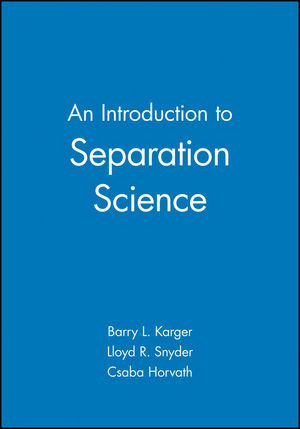An Introduction to Separation ScienceISBN: 978-0-471-45860-9
Hardcover
608 pages
November 1973
 This is a Print-on-Demand title. It will be printed specifically to fill your order. Please allow an additional 10-15 days delivery time. The book is not returnable.
|
||||||
Master Symbol List
Chapter 1. Introduction
1.1 Historical Perspective
1.2 The Profusion of Separation Methods
1.3 About the Book
Part One Fundamentals
Chapter 2. Separation Equilibria
2.1 Thermodynamics of Separation
2.2 The Molecular Basis of Equilibrium Separations
Chapter 3. Diffusion and Mass Transport
3.1 Introduction
3.2 Diffusion
3.3 Diffusion Rates in Various Media
3.4 Thermal Diffusion
3.5 Mass Transfer through Interfaces
3.6 Fluid Flow
Chapter 4. Operational Aspects of Separation
4.1 Terminology and Classification
4.2 Single-Contact (Cocurrent) Processes
4.3 Differential Processes
4.4 Crosscurrent Processes
4.5 Countercurrent Processes
4.6 Countercurrent Processes with Reflux
4.7 Differential Migration Methods
4.8 Craig Distribution and Chromatography
4.9 Zone Melting
Chapter 5. Chromatography
5.1 Introduction
5.2 Retention and Equilibrium
5.3 The Origin and Importance of Band Spreading
5.4 Resolution
5.5 Multicomponent Separations
Chapter 6. Characteristics of Individual Separation Methods
6.1 Adaptability
6.2 Load Capacity
6.3 Fraction Capacity
6.4 Selectivity
6.5 Speed and Convenience of Separation
Part Two Methods Based on Phase and Distribution Equilibria
Chapter 7. Distillation (R. H. McCormick)
7.1 Introduction
7.2 Theory
7.3 Experimental Techniques
7.4 Other Types of Distillation
Chapter 8. Gas-Liquid Chromatography
8.1 Theory
8.2 Experimental Gas-Liquid Chromatography
8.3 Typical Applications
Chapter 9. Solvent Extraction (H. Freiser)
9.1 Introduction
9.2 Process of Extraction
9.3 Classification of Inorganic Extraction Systems
9.4 Fundamental Extraction Parameters
9.5 Methods of Extraction
9.6 Quantitative Treatment of Extraction Equilibria
Chapter 10. Liquid-Liquid Chromatography
10.1 Theory
10.2 Column Chromatography
10.3 Paper Chromatography
10.4 Some Related Methods
10.5 Applications
Chapter 11. Crystallization (W. R. Wilcox)
11.1 Introduction
11.2 Crystallization Phenomena
11.3 Separation by Crystallization
11.4 Phenomena Influencing Separation
11.5 Related Processes
Chapter 12. Ion-Exchange Separation Processes (H. L. Rothbart)
12.1 Introduction
12.2 Structure
12.3 Properties of Ion Exchangers
12.4 Applications
12.5 Chromatography
Chapter 13. Liquid-Solid Adsorption Chromatography
13.1 Theory
13.2 Experimental Aspects
13.3 Some Related Methods
13.4 Affinity Chromatography
13.5 Applications
Chapter 14. Other Interfacial Processes
14.1 Gas-Solid Adsorption
14.2 Adsorption Bubble Separation Processes
Chapter 15. Exclusion Processes (J. Y. Chuang and J. F. Johnson)
15.1 Adsorption on Molecular Sieves (Zeolites)
15.2 Gel Chromatography
15.3 Clathration
Part Three Other Separation Methods
Chapter 16. Barrier Separation Processes (R. A. Cross and H. Strathmann)
16.1 Introduction
16.2 Structure and Transport Properties of Semipermeable Membranes
16.3 Fluxes and Driving Forces in Membrane Separation Processes
16.4 Theory and Practice of Selected Membrane Separation Processes
Chapter 17. Electrophoresis (M. Bier)
17.1 Introduction
17.2 Theory
17.3 Techniques
Chapter 18. Miscellaneous Separation Processes
18.1 Ultracentrifugation
18.2 Particle Classification by Size
18.3 Electromagnetic Separation (Mass Spectrometry)
18.4 Thermal Diffusion
18.5 The Use of Enzymes for Separation
Chapter 19. Multistep Separation Schemes for Complex Samples
19.1 Designing a Multistep Scheme
19.2 Some Examples of Separation Schemes
19.3 Conclusion
Index
Chapter 1. Introduction
1.1 Historical Perspective
1.2 The Profusion of Separation Methods
1.3 About the Book
Part One Fundamentals
Chapter 2. Separation Equilibria
2.1 Thermodynamics of Separation
2.2 The Molecular Basis of Equilibrium Separations
Chapter 3. Diffusion and Mass Transport
3.1 Introduction
3.2 Diffusion
3.3 Diffusion Rates in Various Media
3.4 Thermal Diffusion
3.5 Mass Transfer through Interfaces
3.6 Fluid Flow
Chapter 4. Operational Aspects of Separation
4.1 Terminology and Classification
4.2 Single-Contact (Cocurrent) Processes
4.3 Differential Processes
4.4 Crosscurrent Processes
4.5 Countercurrent Processes
4.6 Countercurrent Processes with Reflux
4.7 Differential Migration Methods
4.8 Craig Distribution and Chromatography
4.9 Zone Melting
Chapter 5. Chromatography
5.1 Introduction
5.2 Retention and Equilibrium
5.3 The Origin and Importance of Band Spreading
5.4 Resolution
5.5 Multicomponent Separations
Chapter 6. Characteristics of Individual Separation Methods
6.1 Adaptability
6.2 Load Capacity
6.3 Fraction Capacity
6.4 Selectivity
6.5 Speed and Convenience of Separation
Part Two Methods Based on Phase and Distribution Equilibria
Chapter 7. Distillation (R. H. McCormick)
7.1 Introduction
7.2 Theory
7.3 Experimental Techniques
7.4 Other Types of Distillation
Chapter 8. Gas-Liquid Chromatography
8.1 Theory
8.2 Experimental Gas-Liquid Chromatography
8.3 Typical Applications
Chapter 9. Solvent Extraction (H. Freiser)
9.1 Introduction
9.2 Process of Extraction
9.3 Classification of Inorganic Extraction Systems
9.4 Fundamental Extraction Parameters
9.5 Methods of Extraction
9.6 Quantitative Treatment of Extraction Equilibria
Chapter 10. Liquid-Liquid Chromatography
10.1 Theory
10.2 Column Chromatography
10.3 Paper Chromatography
10.4 Some Related Methods
10.5 Applications
Chapter 11. Crystallization (W. R. Wilcox)
11.1 Introduction
11.2 Crystallization Phenomena
11.3 Separation by Crystallization
11.4 Phenomena Influencing Separation
11.5 Related Processes
Chapter 12. Ion-Exchange Separation Processes (H. L. Rothbart)
12.1 Introduction
12.2 Structure
12.3 Properties of Ion Exchangers
12.4 Applications
12.5 Chromatography
Chapter 13. Liquid-Solid Adsorption Chromatography
13.1 Theory
13.2 Experimental Aspects
13.3 Some Related Methods
13.4 Affinity Chromatography
13.5 Applications
Chapter 14. Other Interfacial Processes
14.1 Gas-Solid Adsorption
14.2 Adsorption Bubble Separation Processes
Chapter 15. Exclusion Processes (J. Y. Chuang and J. F. Johnson)
15.1 Adsorption on Molecular Sieves (Zeolites)
15.2 Gel Chromatography
15.3 Clathration
Part Three Other Separation Methods
Chapter 16. Barrier Separation Processes (R. A. Cross and H. Strathmann)
16.1 Introduction
16.2 Structure and Transport Properties of Semipermeable Membranes
16.3 Fluxes and Driving Forces in Membrane Separation Processes
16.4 Theory and Practice of Selected Membrane Separation Processes
Chapter 17. Electrophoresis (M. Bier)
17.1 Introduction
17.2 Theory
17.3 Techniques
Chapter 18. Miscellaneous Separation Processes
18.1 Ultracentrifugation
18.2 Particle Classification by Size
18.3 Electromagnetic Separation (Mass Spectrometry)
18.4 Thermal Diffusion
18.5 The Use of Enzymes for Separation
Chapter 19. Multistep Separation Schemes for Complex Samples
19.1 Designing a Multistep Scheme
19.2 Some Examples of Separation Schemes
19.3 Conclusion
Index



